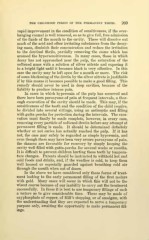Page 421 - My FlipBook
P. 421
THE CHILDHOOD PERIOD OF THE PERMANENT TEETH. 269
rapid improvement in the condition of sensitiveness, if the over-
hanging enamel is well removed, so as to give full, free admission
of the fluids of the mouth to the cavity. These will dissolve out
much of the acid and other irritating substances from the decay-
ing mass, dimmish their concentration and reduce the irritation
to the dentinal fibrils, partially removing -the cause which has
aroused the hypersensitiveness. In many cases, those in which
decay has not approached near the pulp, the saturation of the
softened mass with a solution of silver nitrate and exposing it
to a bright light until it becomes black is very effective. In this
case the cavity may be left open for a month or more. The risk
of some blackening of the dentin by the silver nitrate is justifiable
if by this means it becomes possible to make a good filling. This
remedy should never be used in deep cavities, because of the
liability to produce intense pain.
In cases in which hyperemia of the pulp has occurred and
there have been paroxysms of pain at frequent intervals, a thor-
ough excavation of the cavity should be made. This may, if the
sensitiveness of the tooth and the condition of the child require,
be divided into several sittings, using an antiseptic and filling
with gutta-percha for protection during the intervals. The exca-
vation must finally be made complete, however, in every case,
removing every particle of softened dentin before any attempt at
permanent filling is made. It should be determined definitely
whether or not caries has actually reached the pulp. If it has
not, the case may safely be regarded as simple hyperemia, and
even though there may have been very severe paroxysms of pain,
the chances are favorable for recovery by simply keeping the
cavity well filled with gutta-percha for several weeks or months.
It is difficult to prevent children hurting these teeth by tempera-
ture changes. Parents should be instructed to withhold hot and
cold foods and drinks, and, if the weather is cold, to keep them
well housed or especially guarded against breathing cold air
through the mouth when out of doors.
In the above we have considered only those forms of treat-
ment looking to the early permanent filling of the first molars
with gold. Many cases will occur in which this will not be the
wisest course because of our inability to carry out the treatment
successfully. In these it is best to use temporary fillings of such
a nature as to give considerable time. These may be made of
oxyphosphate of copper, of Hill's stopping, or of amalgam, with
the understanding that they are expected to serve a temporary
purpose only, awaiting the opportunity to make permanent fill-
ings.


